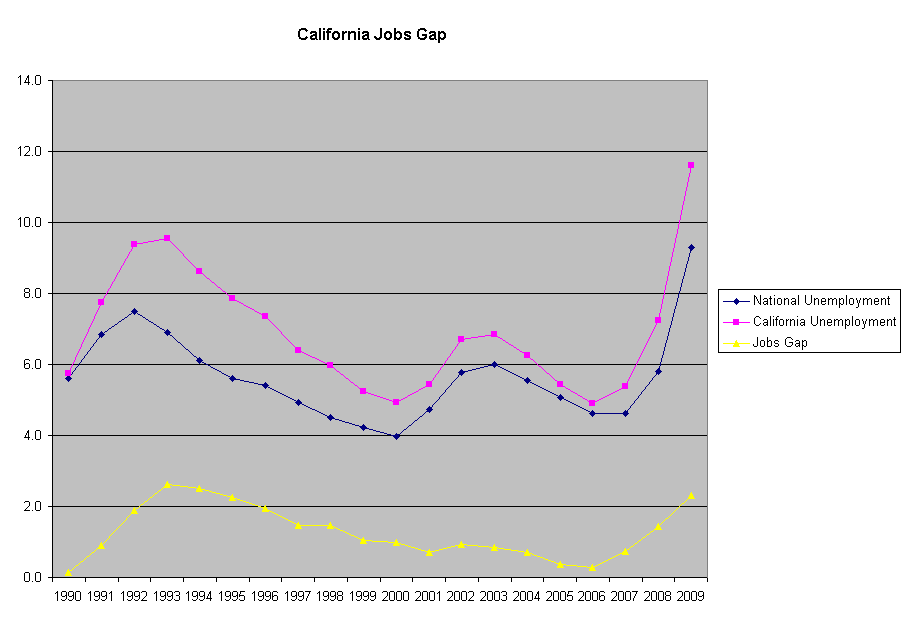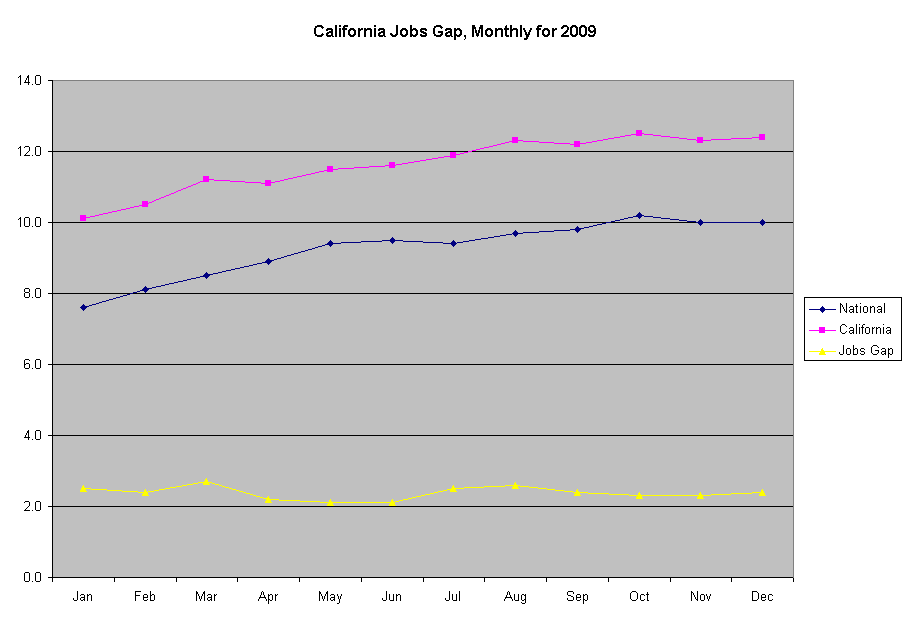California Jobs Gap Grows
by CalWatchdog Staff | January 22, 2010 8:13 am

Jan. 25, 2010
By JOHN SEILER
In an earlier article I introduced[1] a new measure of economic vitality: the Jobs Gap. It measures the difference between unemployment in California and the rest of the country. It thus factors out the national economic climate, which is affected mainly by policies in Washington, D.C., allowing us to focus on the specific policies – for or against jobs creation – of California’s government.
The Jobs Gap is calculated by subtracting the U.S. unemployment rate from the California unemployment rate. In November 2009, the U.S. unemployment rate was 10.0 percent and the California rate 12.3 percent. So the California Jobs Gap was 2.3 percentage points.
Data released Friday[2] by the Bureau of Labor Statistics of the U.S. Department of Labor show that the Jobs Gap has grown. Unemployment in the United States was 10 percent in December 2009, unchanged from November. But unemployment in California rose to 12.4 percent, for a Jobs Gap of 2.4 percentage points. That’s 0.2 points higher than a month earlier.
However, the month-to-month figures aren’t what’s pertinent, Esmael Adibi told me; he’s director of the A. Gary Anderson Center for Economic Research[3] and Anderson Chair of Economic Analysis. The key is the trend.
The trend clearly was up from 2006-08, as the following chart shows. This is an updated version of a chart I used in my original article. The yellow line is the Jobs Gap for California, by year, showing it rising since 2006. That article indicated that the change in policies of Gov. Arnold Schwarzenegger, from being pro-business in 2003-2005, to pro-regulation and pro-tax from 2006-now, were the likely cause of the gap.

The second chart, below, is a new chart showing the Jobs Gap for all of 2009. What is curious that the Jobs Gap, again the bottom yellow line, remained constant the past year, hovering around 2.4 percentage points, exactly the number for December 2009.

Noted the Bureau of Labor Statistics’ latest report[4], released Friday: “In December, non-farm payroll employment increased in 11 states and the District of Columbia and decreased in 39 states…. The largest over-the-month decrease in employment occurred in California (-38,800).” So, we’re falling behind.
Improvement a long way off
“The labor force changes gradually,” said Adibi of jobs in general. That would be good news if California had a small Jobs Gap. But with a high Jobs Gap, it means it will be more difficult to make up for past job losses once a national recovery is under way. Adibi said that he expects “unemployment will be around 12 percent for an extended period. I don’t see it going down anytime soon.”
He said that jobs creation is needed not only to put the unemployed back to work, but to provide work for kids just leaving school and starting their careers. Worse, as recessions typically end, unemployment usually remains stubbornly low. Employers don’t want to risk hiring new workers until they’re sure the recovery is for real. And many discouraged workers, who had stopped looking for jobs, start looking again once the first signs of a recovery occur.
California “got hit harder” than the national economy, Adibi added, because the devastation to the housing and construction industries was greater here than in other parts of the country. “Those areas will come back slow.”
Uncertainty from higher taxes and the state budget problems also will discourage businesses from creating jobs. “If you talk to small businesses, they’re getting it from every angle – taxes, regulations, maybe the national health care bill. They’re not rushing out and creating jobs.”
This information might prove useful to Gov. Schwarzenegger and the Legislature as they contemplate how to close the $20 billion budget deficit.
Soon, voters will have their say in the matter in the June primary and November general elections. In a year, California will have a new governor and dozens of new legislators. Their policies will decide which direction California’s Jobs Gap will take.
John Seiler, an editorial writer for 19 years at The Orange County Register, currently is a reporter and analyst for Calwatchdog.com. His email: [email protected][5].
—————————————————————————————————————————————————–
Appendix
The yearly Jobs Gap data are in my earlier article[6].
Here are the monthly unemployment and Jobs Gap data for 2009:
| Month | National | California | Jobs Gap | |
|
Jan |
7.6 |
10.1 |
2.5 |
|
|
Feb |
8.1 |
10.5 |
2.4 |
|
|
Mar |
8.5 |
11.2 |
2.7 |
|
|
Apr |
8.9 |
11.1 |
2.2 |
|
|
May |
9.4 |
11.5 |
2.1 |
|
|
Jun |
9.5 |
11.6 |
2.1 |
|
|
Jul |
9.4 |
11.9 |
2.5 |
|
|
Aug |
9.7 |
12.3 |
2.6 |
|
|
Sep |
9.8 |
12.2 |
2.4 |
|
|
Oct |
10.2 |
12.5 |
2.3 |
|
|
Nov |
10.0 |
12.3 |
2.3 |
|
|
Dec |
10.0 |
12.4 |
2.4 |
|
- I introduced: http://../2010/01/10/new-californias-growing-jobs-gap/
- Data released Friday: http://www.bls.gov/news.release/laus.nr0.htm
- A. Gary Anderson Center for Economic Research: http://www.chapman.edu/argyros/asbecenters/acer/default.asp
- latest report: http://www.bls.gov/news.release/laus.nr0.htm
- [email protected]: mailto:[email protected]
- my earlier article: http://www.calwatchdog.com/2010/01/10/new-californias-growing-jobs-gap/
Source URL: https://calwatchdog.com/2010/01/22/new-california-jobs-gap-grows/